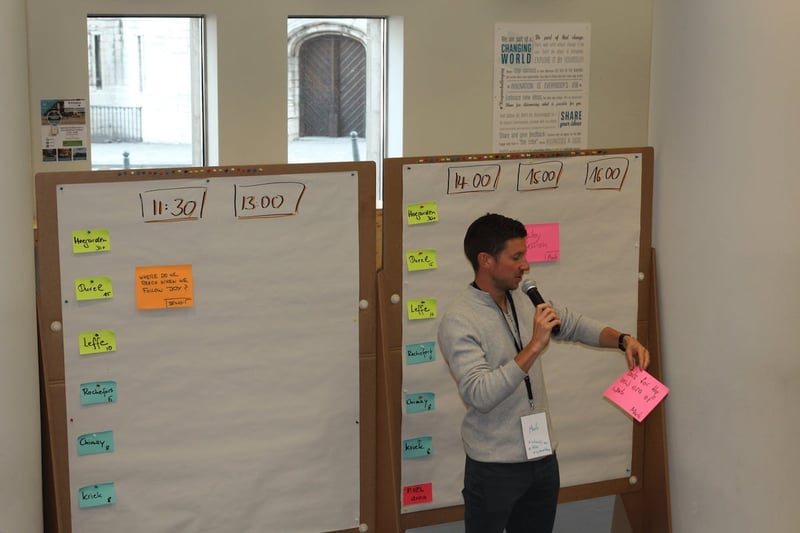Hosting an effective Unconference: A how-to guide for teams

Just like many other movements, the New World of Work, short NWOW, introduces new trends, tools and buzzwords. Although it's been around since the late 90s, participating in an ‘Unconference’ only recently became popular for people of the scene.
While ‘normal’ conferences come with an agenda, unconferences come without one. The program is shaped by the participants on the day of the event. So, you never really know what to expect. Only one thing is for sure: prepare to be surprised!
At Proxyclick, we’ve hosted our own small unconference within our team during our remote-working experiment in Barcelona.
We were amazed how our initial doubts of giving up control by doing a topic-less workshop become redundant. Even half a year later we are still benefiting from the positive long term effects of the process as an organization and team.
We want to share our learnings with others who are, just like we were, curious about how an unconference works in practice.
Here is our how-to guide on how you too can host an effective unconference at your workplace:
What is an Unconference?
Unconferences originate from the participant-driven Open Space Technology method by Harrison Owen. At the opening of the unconference, participants find themselves presented with an empty agenda. Everybody who feels called to initiate a session can claim time and space to host a conversation on topics that matter to them.
Attendees can host and participate to as many sessions they like and can even freely move between sessions that are hosted at the same time.
Unconferences can be held for small teams of 5 people for half a day to 1000+ employee conventions for an entire weekend.
In our case, we were 15 people.
Why should you organize an Unconference in your company?
For our team, the unconference came with 3 main benefits:
1. Answer to a calling question
Our team is growing rapidly. Since I started at Proxyclick 1 ½ years ago, we’ve doubled in size. Naturally, we noticed that we couldn’t continue working in the same fashion as we used to in a much smaller team. Our leading question and theme of our unconference became therefore: “What positive changes do we want to see or create at Proxyclick to improve the way we work.”
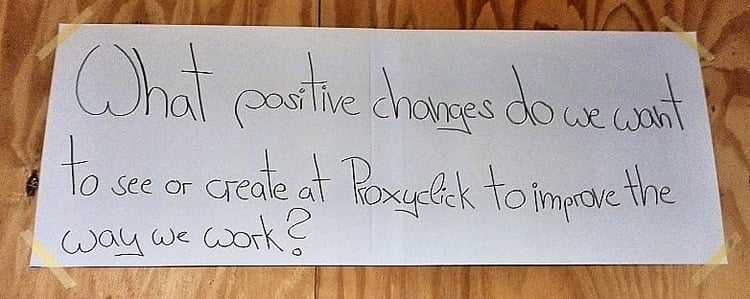
The proposed topics, the direction in which conversations went and the attendance of the sessions held during the unconference gave us a helicopter view on what improvements the team felt strongly about.
2. Increase of team spirit
Unconferences have the wonderful effect that they will bring people together who are passionate about the same topic, no matter of their role within the organization.
Cleaning staff, the marketing department and even the CEO might find themselves in the same discussion group on how to make the corridors more friendly-looking. Or like in our case, having developers and accounting sitting together at the same table discussing knowledge sharing tools.
I also noted that the unconference was a great reminder that we all strive towards a common goal. Seeing how passionate other team members were engaged in the conversations was contagious. We suddenly noticed: “Oh, it isn’t just me who thought about that.”
3. Long-term participant leadership
The unconference did not end in Barcelona. As the proposed changes didn’t come from top-down but emerged from the team, we naturally feel a bigger sense of ownership for the outcome.
Working groups were formed in which different colleagues are taking the lead. E.g. we have a fun team now that organizes monthly after-work events and another group tested different wiki options to make internal knowledge easier and more accessible for remote workers before deciding to implement Tettra.
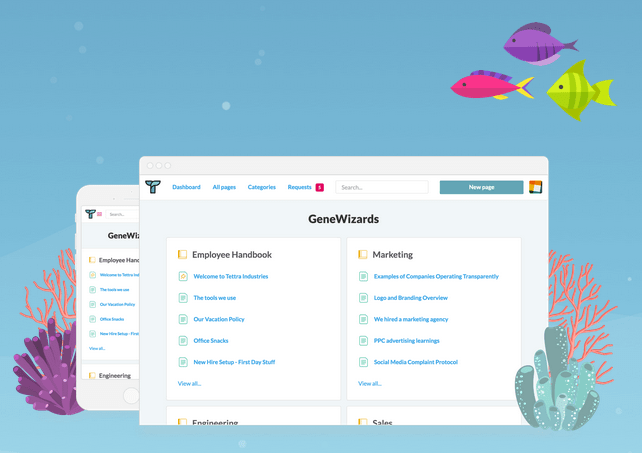 Taking the lead: One work group tested wiki options to make information access easier for our remote workers
Taking the lead: One work group tested wiki options to make information access easier for our remote workers
How do you prepare for an Unconference?
Weeks before the event: Plan scope of event
- Decide on number of participants, time etc.
- Decide on date and space options
- Book but also ideally visit the space before the event if you are not in-house
- Decide on leading question that provides the general direction and tone of your event (Anyone who you’d like to include for that?)
- Send an invite
Days before the event: Prepare material
- Buy materials
- Prepare signs and posters
On the day: Set up the space
- Marketspace for opening and ending of unconference (chairs, agenda with general room and time slot indications, wall with outcomes of the sessions)
- Chill-out and food/drinks corner for longer unconferences
- Spaces for sessions (rooms or different corners within a room are fine), tables and chairs, materials and/or flip-charts/whiteboards to doodle if available
- Hang signs and posters that people can find their way and are reminded of the rules of the game
How to facilitate an Unconference?
Your role as facilitator
The role of the facilitator is to provide the space, time and structure of the event. Open the event with a few inspiring words, the leading question if you have one and very clear instructions, so nobody feels lost.
Inform the participants of the 4 principles:
- Whoever comes are the right people.
- Whatever happens is the only thing that could have (happened?).
- Whenever it starts is the right time.
- When it is over it is over.
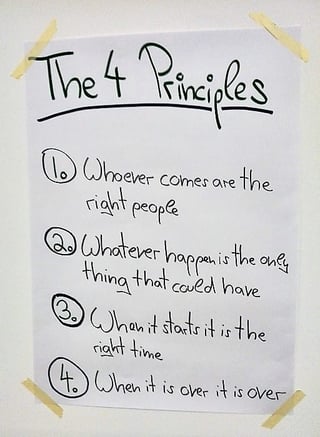
Explain the "Law of the Two Feet"
Anyone finds her or himself in a situation where they are neither learning nor contributing, they can use their two feet to go to a more productive place. This law is important as it emphasizes that every participant is present voluntarily.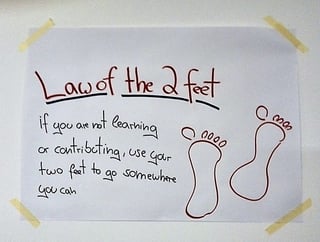
Last but not least, make sure the outcomes of the sessions are documented and shared during and/or at the end of the unconference.
The roles of the participants
Participants can either host a session or participate in a session. Of course, they can also do both.
Participants can also function as a bumble bee and jump back and forth to ongoing sessions and pullulate other conversations with new ideas and insights from other groups.
Especially in larger settings in which an unconference can last one day or more, the role of the butterfly emerges. Butterflies take a break of the ongoing sessions and find themselves often at the buffet or chill-out area. When two butterflies meet, they might end up having the deepest conversation of the whole unconference.
How to maximize the outcomes of the Unconference
A good idea is to provide each session-table with posters to doodle (e.g. flipchart paper is an excellent choice) or other material to document the outcomes of each discussion. You can also set up a material table from which the participants can get whatever they need: post-its, paper, pens, markers etc.
We worked with smaller sheets in which we indicated the topic, the ideas, the feasibility and the concrete next steps to make our ideas reality.
After each session, we hung the sheet on a first empty but quickly filling wall with our “Breaking News”.
Before we closed the unconference and called it a day, we came all together to the wall and pitched for 30 seconds the outcomes to the rest of the team.
Back in Brussels, we selected from our initial 14 new initiatives, the 4 most important projects by voting. 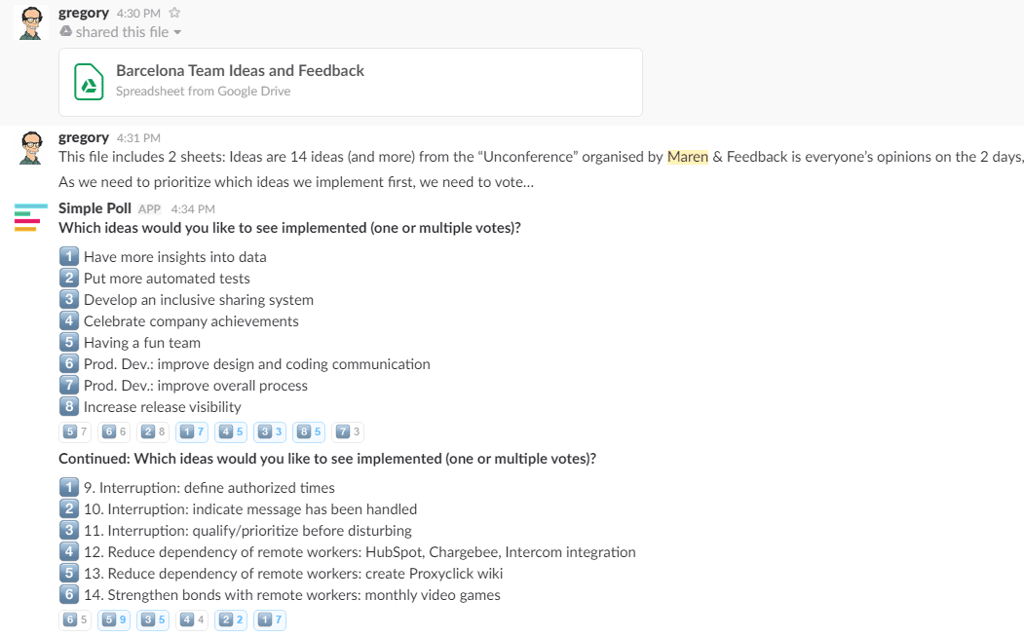
From 14 ideas to 4: Team Proxyclick votes on Slack
Then we decided to which project we wanted to contribute and for which we might even want to take ownership of.
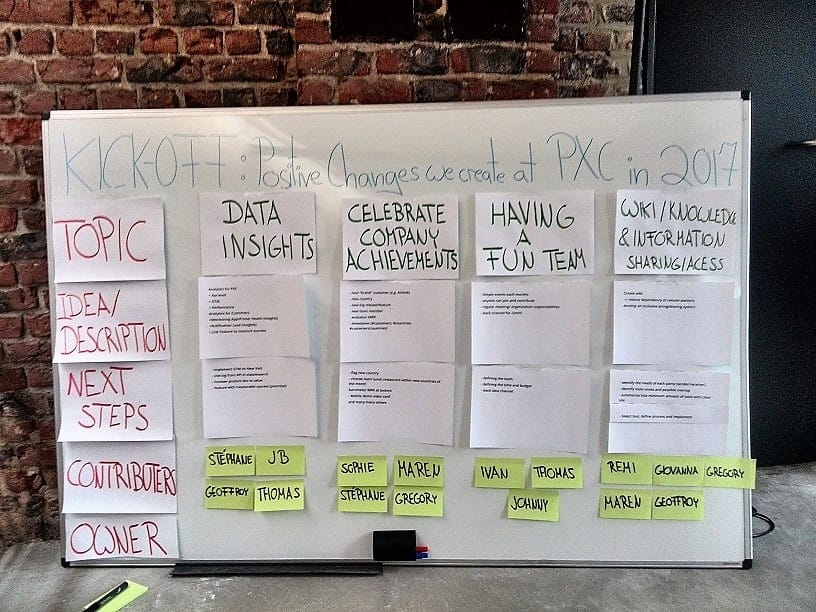 The 4 initiatives we have chosen to put into action in 2017
The 4 initiatives we have chosen to put into action in 2017
Our biggest (un)learning…
One of the biggest concerns you may have if you facilitate an unconference for the first time is: “Will anyone come with a topic? What if nobody says anything?”.
At the end, it was a redundant concern. My colleagues had so many burning topics. We had no problems filling the agenda wall.
Some of us were even upset when they noticed a time slot in which two sessions happened they were both interested in. So, we moved a couple of sessions back and forth on our agenda wall to ensure almost everybody could participate where he or she wanted to.
If there are people working together, there will be burning topics that want to come out.
All you need to do is to provide the time and space.
So, trust your team. Trust the process. Trust yourself. And prepare to be surprised.



